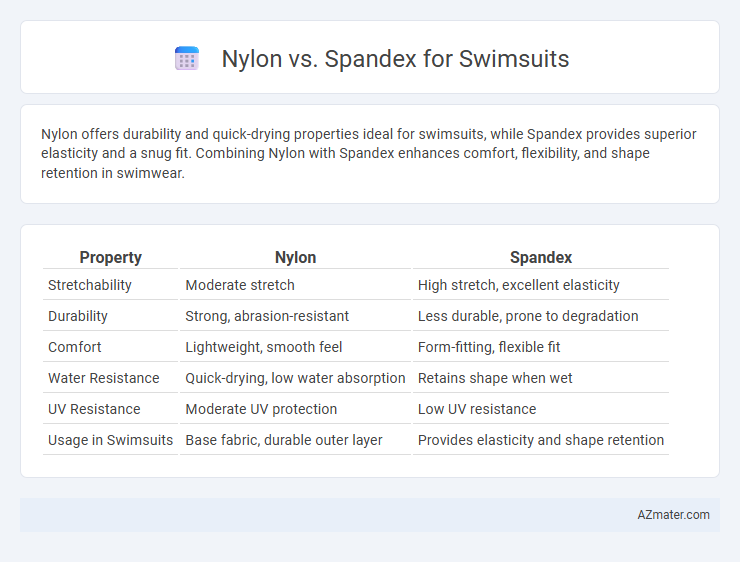Nylon offers durability and quick-drying properties ideal for swimsuits, while Spandex provides superior elasticity and a snug fit. Combining Nylon with Spandex enhances comfort, flexibility, and shape retention in swimwear.
Table of Comparison
| Property | Nylon | Spandex |
|---|---|---|
| Stretchability | Moderate stretch | High stretch, excellent elasticity |
| Durability | Strong, abrasion-resistant | Less durable, prone to degradation |
| Comfort | Lightweight, smooth feel | Form-fitting, flexible fit |
| Water Resistance | Quick-drying, low water absorption | Retains shape when wet |
| UV Resistance | Moderate UV protection | Low UV resistance |
| Usage in Swimsuits | Base fabric, durable outer layer | Provides elasticity and shape retention |
Introduction to Swimsuit Fabrics
Nylon and spandex are two of the most popular fabrics used in swimsuits due to their durability and stretchability. Nylon offers excellent resistance to abrasion, quick-drying properties, and a smooth feel against the skin, making it ideal for water activities. Spandex provides superior elasticity and shape retention, allowing swimsuits to fit snugly and move comfortably with the body during swimming.
What is Nylon?
Nylon is a synthetic polymer known for its exceptional strength, elasticity, and resistance to abrasion, making it a popular choice in swimsuit fabrics. It offers quick-drying properties and durability against chlorine, saltwater, and sunlight, ensuring longevity in swimwear. Compared to spandex, nylon provides a more structured fit and less stretch, often blended to enhance flexibility and comfort.
What is Spandex?
Spandex is a synthetic fiber known for its exceptional elasticity, allowing swimsuits to stretch up to five times their original size while maintaining shape and comfort. Often blended with nylon, spandex enhances the durability and flexibility of swimwear, providing a snug fit and freedom of movement. Its resistance to chlorine and UV rays makes spandex a popular choice in competitive and recreational swimsuits.
Key Differences Between Nylon and Spandex
Nylon offers durability, quick-drying properties, and resistance to abrasion, making it ideal for the structural base of swimsuits, while spandex provides exceptional elasticity and stretch for enhanced comfort and fit. Nylon fibers are generally less elastic but more resilient to wear and UV exposure, whereas spandex excels in stretch recovery and flexibility but may degrade faster with chlorine exposure. Combining nylon with spandex creates a balanced swimsuit fabric that maximizes strength, shape retention, and freedom of movement.
Durability: Nylon vs Spandex
Nylon is highly durable and resistant to abrasion, making it ideal for swimsuits that endure frequent use and exposure to chlorine and saltwater. Spandex offers exceptional stretch and flexibility but is less resistant to wear and can degrade faster when exposed to harsh chemicals or prolonged sun exposure. Combining nylon with spandex creates a balanced fabric blend that maintains durability while providing necessary elasticity for swimwear performance.
Comfort and Fit Comparison
Nylon offers a smooth, lightweight feel and excellent durability, ensuring swimsuits maintain their shape over time without feeling restrictive. Spandex provides exceptional elasticity and stretch, adapting closely to body contours for a snug, flexible fit that enhances mobility. Together, nylon's strength and spandex's stretch combine to deliver superior comfort and a form-fitting swimsuit ideal for active use.
Water Resistance and Quick Drying
Nylon swimsuits offer superior water resistance due to their low water absorption, making them ideal for prolonged use in water. Spandex, although highly stretchable, tends to absorb more water, resulting in slower drying times compared to nylon. Combining nylon with spandex blends enhances both quick-drying properties and elasticity, optimizing swimsuit performance for water activities.
Color Retention and Fading
Nylon swimsuits offer excellent color retention due to their strong resistance to UV rays and chlorine, which significantly reduces fading over time. Spandex, while providing superior stretch and comfort, tends to fade faster when exposed to prolonged sunlight and frequent exposure to pool chemicals. Combining nylon with spandex in swimsuits ensures both vibrant, long-lasting colors and optimal flexibility for enhanced wearability.
Cost and Availability
Nylon swimsuits generally cost less and are widely available, making them a popular choice for budget-conscious buyers. Spandex suits often have a higher price due to their superior stretch and durability but can be harder to find in budget ranges. Both materials are commonly stocked by major retailers, yet nylon remains more accessible for everyday consumers.
Which is Better for Swimsuits?
Nylon offers exceptional durability, resistance to chlorine, and quick-drying properties, making it a popular choice for long-lasting swimsuits. Spandex provides superior elasticity and stretch, ensuring a snug and flexible fit that enhances comfort and freedom of movement in swimwear. Combining nylon with spandex blends the durability and resilience of nylon with the flexibility of spandex, creating the ideal fabric for high-performance swimsuits.

Infographic: Nylon vs Spandex for Swimsuit
 azmater.com
azmater.com